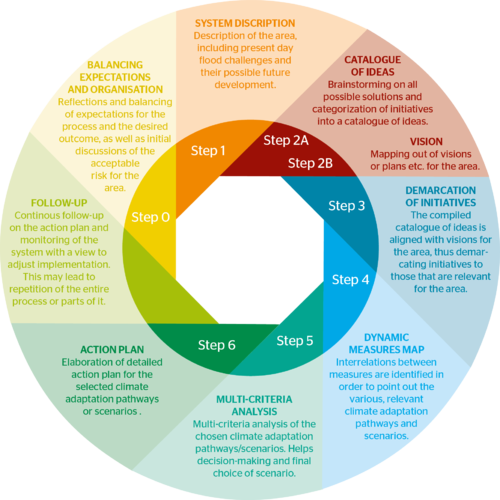Implementation process
Point of departure of FRM strategies
There is a sluice in the water course Omløbsåen, and small dikes along parts of the rivers in the height of 2 m to prevent flooding from the water courses (interview pilot manager, 2019). When closed, the flood gate will prevent high water levels in the fjord from entering Omløbsåen, where it otherwise would cause flooding. Three motor-driven sluice gates are also located further upstream in Omløbsåen, allowing automated and remote control. However, sea-levels are expected to rise by 25 cm in the fjord by 2050, and it is at serious risk of flooding due to its low-level topography (DHI, 2019).
Currently, protection from the side of the fjord is on the agenda. Options discussed (DCA with the Vejle Municipality) are a sea wall barrier, also the option to protect the harbour area, cutting off the harbor area or a major storm surge barrier in the same area that will close up the entire city during a storm surge. The storm surge barrier would cross the entire fjord and also function as a green area. One solution would be to have a sluice to hold back the water (interview pilot manager, 2019)
The new parts of the cities are built on raised terrain and they are also building higher foundations for the houses. This makes these areas flood proof without building a sea wall, but it might not be high enough considering the expected sea rise level (interview pilot manager, 2019).
This area was chosen as part of the project because it is an area of potential significant flood risk as part of the Floods Directive and it is a member of the list of 100 resilient cities.
Desired score to reach per layer in this pilot (Baseline survey, 2019).
Stakeholders involved
- Danish Coastal Authority
- Municipality of Vejle
- Department of Technology and Environment
- PhD student from Aarhus University, focusing on awareness raising
Role of key actors
The Danish Coastal Authority is an independent agency under the Danish Ministry of Environment and Food. The authority’s functions include analysis and guidance on coastal and flooding protection and the administration of the state territorial waters. Moreover, the Danish Coastal Authority functions as adviser to The Minister of Environment and Food.
In this project, the DCA worked together with the municipality. The municipality was very interested and collaborative in working together with the DCA and gave valuable input to the development of the DAPP steps.
Main activities
First, the DCA had to find out the way to work with the method since it was not applied for very specific contexts in flood risk management (FRM) in a Danish context.So a workshop was organized where Deltares, the developer of this method, brainstormed with the DCA on how to implement this approach in Vejle. The following steps have been taken (see figure below from the DCA:
Step 0: reflections and balancing expectation: since the method is relatively unknown in Denmark, the project members had to familiarize themselves with the method, and adapt it to the Danish situation and standards. A framework was developed with six steps. Each step has to be taken with a municipality and the method will be adjusted, if necessary, based on the outcomes of that particular exercise.
Step 1: System description: describe current situation, the system and possible future changes
Step 2A: Catalogue of ideas: Brainstorming measures for flood risk management
Step 2B: Vision: Mapping the vision and plans for the area. Brainstorming for measures but also thinking about what kind of visions the municipality has for the city. Measures such as open storm surge barrier together with the sluice, recreation protection wall, protection wall where buildings can be built, raising terrain, etc.
Step 3: Demarcation of initiatives: combine the visions with the possible measures and remove some measures that do not match with the vision for the area.
Step 4: Dynamic measures map: create pathways. Create the DAPP maps with the measures based on the risk reduction in the area. A total of 3 workshops were required for this step. No politicians were involved in this step.
Step 5: Multi-criteria analysis: create a MCA of the chosen adaptation pathways.
Step 6: Action plan: develop an action plan for short/medium/ long term for a chosen pathway. The results will be presented to politicians.
Step 7: Follow-up: after all steps have been taken, both Danish municipalities (Vejle and Assens) will discuss the process and maps together: what went well, what was bad, what can be changed. This will result in feedback and recommendations for future similar projects.
Every step required one full day meeting with the municipalities, except step 4 which required a 3 days meeting. The municipality was very reactive and cooperative in the whole process, they are very interested in working with the method and give input on the method to DCA.
The result will be presented to the Danish municipalites, during meetings and by a guide on running the Dynamic Planning Proces. Some results are incoorperated in the guide for making flood risk management plans for the municipalites appointed as APSFRs under the Floods Directive, and, when applicable, when the DCA performs risk management plans in other municipalities.
A so-called FRAMES day has already taken place - several municipalities were invited to join the discussions and presentations about the DAPP approach.

